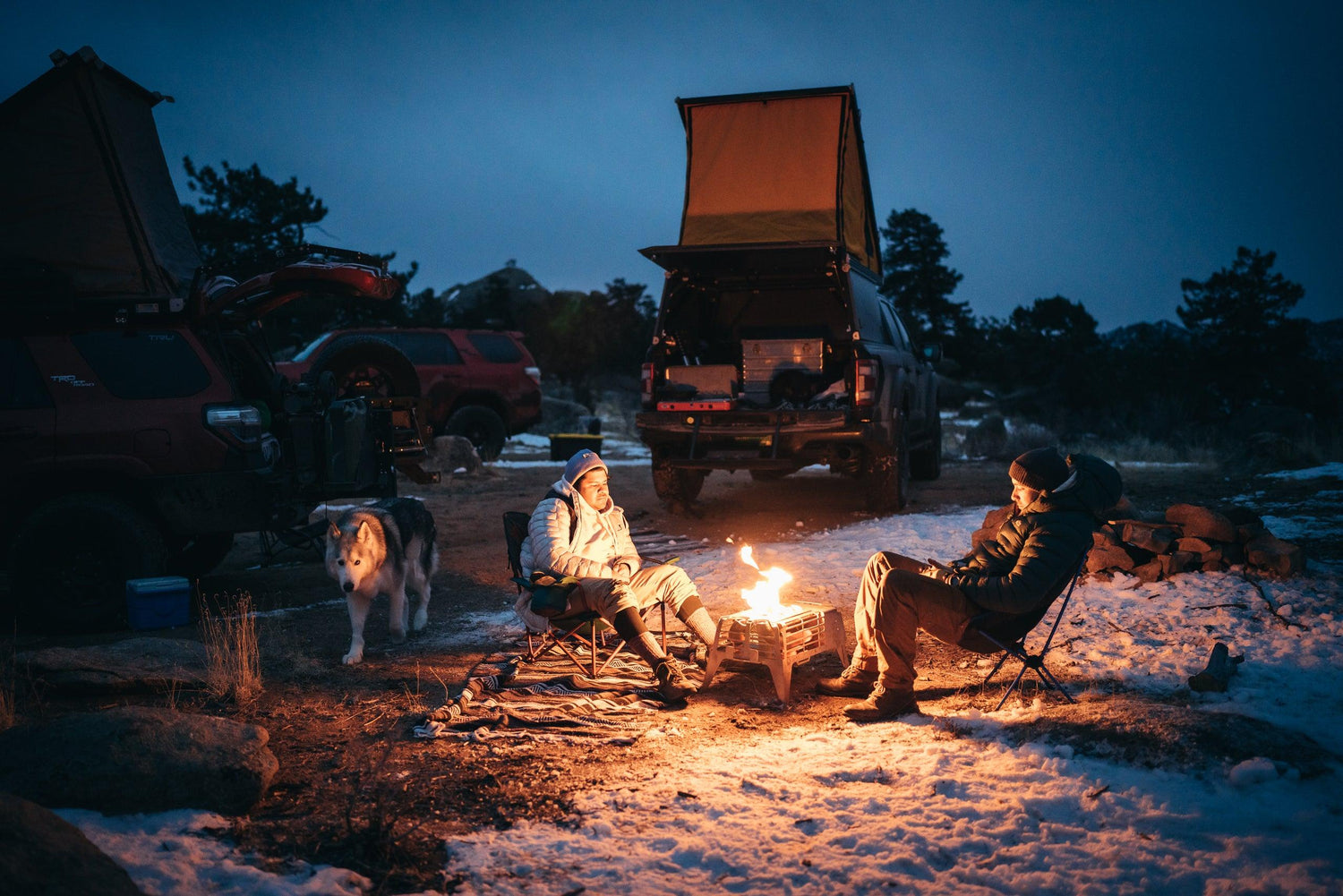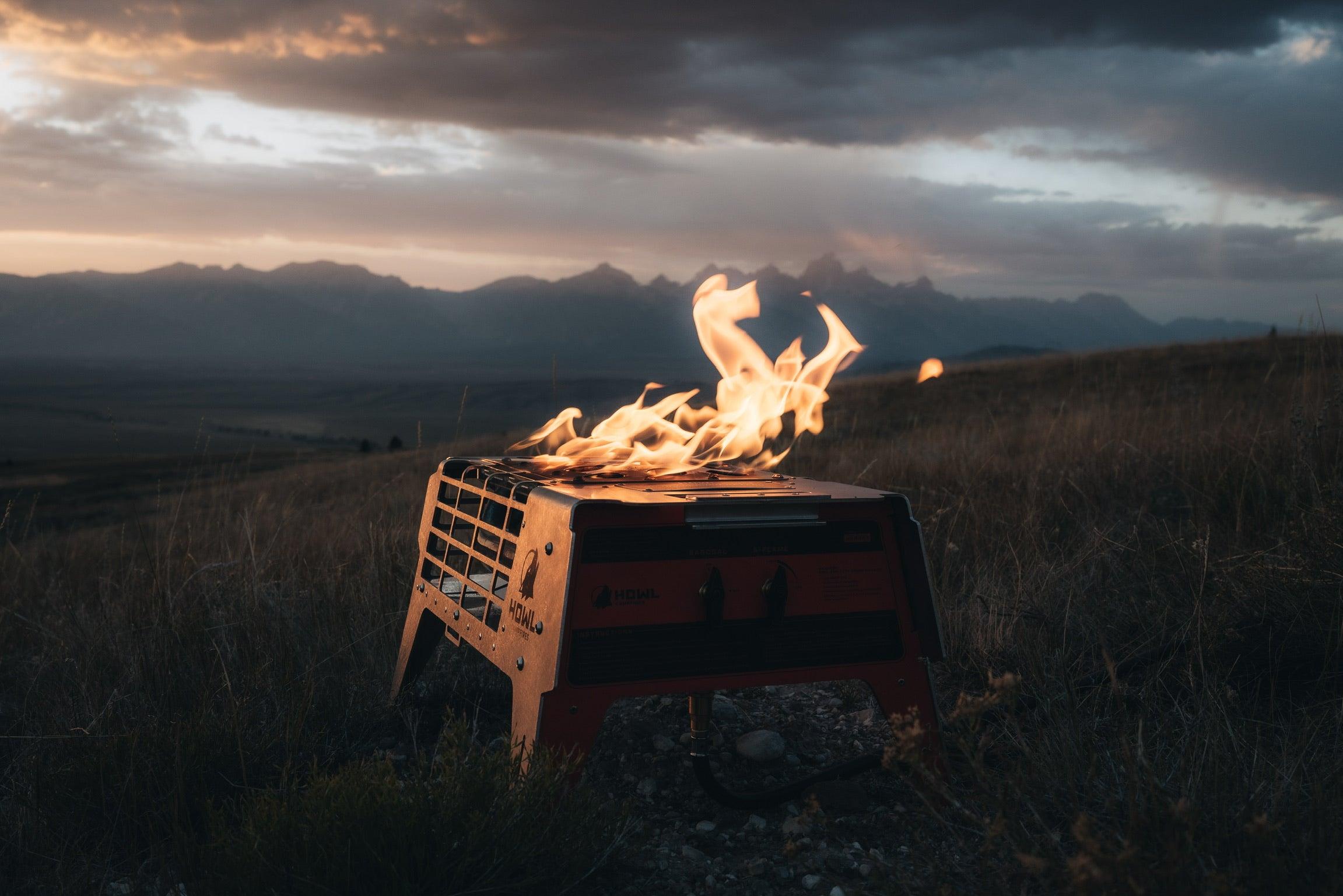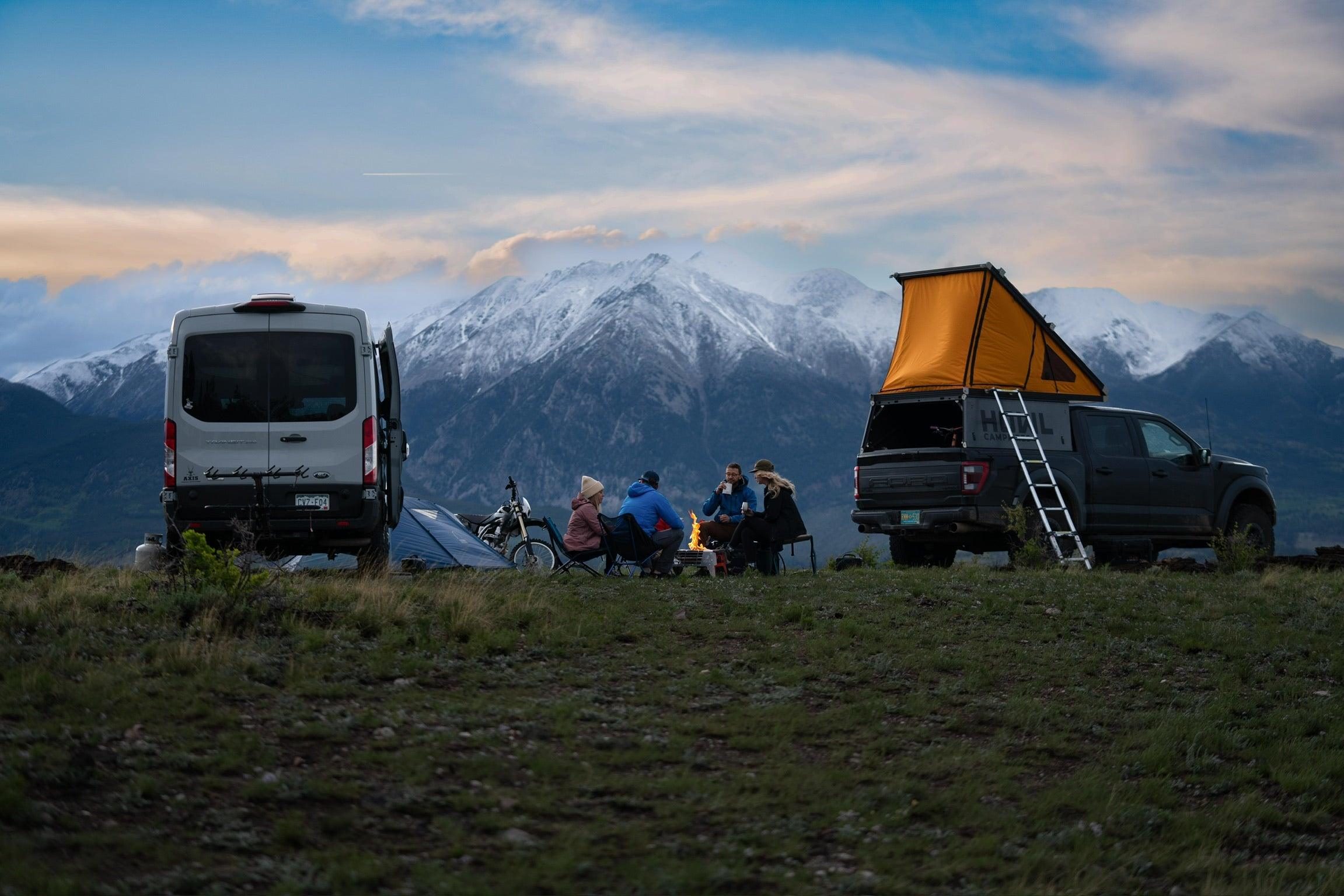Introduction to portable propane firepits
We need campfires. Just sitting next to a fire in the forest touches some of the oldest parts of our brains, telling us that we’re safe, that there’s no danger from predators, or from cold. Our deep ancestral memory is why we can relax and recharge around a campfire in ways that just aren't possible in any other circumstance.
But there's a problem. Wood fires aren’t always an option. In a lot of places, burn bans prohibit them to protect forests. In other places, you can’t leave piles of ash and coal. Even where you can have a wood fire, smoke can be a problem. And wood fires can be difficult to light and keep going, especially in inclement weather.
With all these obstacles facing us, backcountry campers, overlanders, and RVers look to portable propane fire pits to do the job.
More campers than ever need a fire that delivers functional heat, so many of them are looking closely at BTU ratings. But if you want to be warm, will more BTUs actually give you more heat?
BTU ratings in Propane Fire Pits: Here’s what they tell you (and what they don't)
First, you need to know what a BTU is. At its simplest, a BTU is an amount of fuel, like a gallon. One gallon of propane converts to 91,452 BTUs.
The BTU rating on a propane fire pit simply tells you how much fuel it will burn in one hour on its highest setting. For example, a propane fire that’s rated for 90,000 BTUs will burn about a gallon of propane every hour. One that’s rated for 60,000 BTUs will burn about ⅔ of a gallon every hour.
Common Misconceptions about High BTU Ratings
A lot of campers think more BTUs will make them warmer. But the amount of fuel you burn has almost nothing to do with how much heat your body receives.
Think of it like an engine. Bad engines burn a ton of fuel while producing very little horsepower. Good engines give you gobs of horsepower, while using just a small amount of gas. Knowing that, you can see that the amount of gas an engine burns doesn’t really tell you how much power it produces.
It’s the same with propane campfires. Some crush a ton of gas while leaving you out in the cold. Others sip propane while delivering intense, thigh-melting heat.
The bottom line? A BTU rating just isn’t a helpful measure of how much warmth a fire pit makes.
The Reality of Higher BTU Propane Fire Pits
So high-BTU fire pits aren’t guaranteed to keep you warm. But they are guaranteed to cause you some inconveniences. The more fuel you use, the less burn time you’ll get from a tank, which means you’ll spend less time by the fire and more time (and money) going for refills.
But it gets worse. When you pull too much propane from a tank too quickly, it will "freeze off" – meaning there’s not enough pressure in the tank to push the fuel out. That lack of pressure will kill your campfire long before the gas runs out.
On a cool evening, pulling 100,000 BTUs will freeze off a standard 20-lb tank. So you probably don't want a fire pit that pulls so much fuel – unless you can hook it up to a much larger tank.
It’s not about the BTUs, it’s how you use them
If burning more gas isn’t the solution, what is?
There are three ways you can use propane to warm you up. You can:
- Make hot air (flames) and try to get that air to surround you
- Warm up a surface (not too hot!) and then press your body against it
- Make an object so hot that it glows and shoots out photons, which your body absorbs as heat (think of the sun)
If you remember from middle school science, these three types of heat transfer are called 1. Convective, 2. Conductive, and 3. Radiant.
Hot Air (convective heat)
Making hot air is easy. Flames are – by definition – hot air. They appear wherever a stream of exhaust gas is hot enough to light up. But hot air can’t make you warm at camp because it just rises and blows away.
That’s why, when you sit around a propane fire pit that only make flames, no matter how many BTUs you burn, you’ll only feel the heat if you place yourself directly in the exhaust stream (above and downwind of the fire pit).
Hot Surface (conductive heat)
There are no fire pits designed for you to press your body up against them, and that’s probably a good thing. Flames are hot, and this method of heat transfer would fry you like a strip of bacon.
Glowing Object (radiant heat)
The third way to transfer heat to your body is to make an object so hot that it glows like the sun. This is the most effective way to convert BTUs into body heat, and it’s the kind of heat you feel from a wood fire.
After a wood fire’s flames die down, you’re left with a bed of glowing coals, and you can really feel the heat. Those orange coals are shooting out photons in the Infrared spectrum, which your body easily absorbs. The more photons you absorb, the hotter you get, until eventually you need to turn around or back away completely.
Portable propane fire pits that replicate the Infrared Radiant heat of wood coals are like good engines. They use less fuel while making you a whole lot warmer.
The Advantage of Moderate BTU Ratings
When you use less gas, you'll spend more time around your fire and less time refilling your tank. You’ll spend less money on fuel, and you'll have way fewer issues with tank freeze off.
There's a reason most propane fire pits use less than 65,000 BTUs per hour, and that's because in moderate weather, that usage rate isn't enough to freeze off a 20-lb tank. It is also the limit for all fire pits certified for safety under international safety standards.
Even if your fire pit doesn't have infrared capabilities, if it uses a moderate amount of fuel (less than 65,000 BTUs), it will likely offer benefits like operability in colder weather, greater safety for forests and people, and lower requirements for maintenance and cleaning.
Evaluating Your Needs: BTUs and Beyond
Different portable propane fire pits serve different purposes. Before you buy, it’s important that you understand your own needs for a campfire.
Here’s a few questions to consider:
- Do you only camp on warm nights, or in a variety of weather conditions? If you want to camp in more weather conditions, use a fire pit that you like when it's burning less than 65,000 BTUs.
- Do you need a fire pit to provide functional warmth, or do you just need some light and ambiance? If you want warmth, get a fire pit with infrared radiant heat, like the HOWL.
- Do you prefer a giant flame, or one that is more moderately sized? If you want a giant flame, get a fire pit with a huge BTU rating, like the Lavabox.
- Do you need your propane tank to last for multiple nights, or do you only camp one night at a time? If you need your propane tank to last for multiple nights, use a fire pit that you like when it's burning less than 65,000 BTUs.
Do you need a propane fire pit that's UL or CSA Certified?
If you live in Canada and you want to to use a propane fire during a burn ban, you absolutely do. If you're caught using an uncertified propane fire pit, you could face big fines. It is your responsibility to check that the propane fire you own is certified. You can call the company and ask, or you can look on the product. If it bears the UL or CSA symbol shown below, then it is certified for safety.

In the US, there are different overlapping jurisdictions that enact different levels of burn bans and fire restrictions at different times. It's honestly a confusing bureaucratic hot mess. Some fire restriction rules in the US require propane fire pits to be certified to international safety standards, while most don't. You'll want to check your state, county, forest service, BLM, municipal, and HOA regulations for the most up to date information.
Uncertified propane fire pits could put the forest at greater risk
Beyond risking a fine, using an uncertified propane fire pit could increase your risk of starting a wildfire. When a fire pit gets certified to ANSI Safety Standards, that means it has been rigorously tested by scientists and engineers in an accredited third-party laboratory.
The book of ANSI standards describing the tests for outdoor fire pits is 170 pages long. Here are just 5 of the tests that help protect the forest:
- The appliance cannot heat the ground beneath it by more than 90 degrees F
- The appliance cannot fall over when tipped to 30 degrees out of plumb in any direction
- The appliance must light and continue to operate normally in winds of 15 miles per hour
- The appliance must light and continue to operate normally in a deluge of water
- The appliance must not tip over, and must continue to operate normally after significant impacts to its side and top
Many companies making uncertified propane fire pits will claim that their products are safe, and they very well could be. But without a third-party certification, you'll just have to take them at their word and hope they know what they're doing.
Using an uncertified propane fire pit could affect your insurance coverage
Many insurance carriers require certification. According to a recent legal memo from the Denver law firm Goodspeed Merril:
"If an individual has a non-certified fire pit on their property and it happens to malfunction due to no fault of the owner, causing damage to the property, the individual’s property insurance company may deny the claim because the cause of the fire was a faulty part in an uncertified fire pit, and the fault is with the property owner using such a fire pit."
The lack of certification and potential lack of coverage means you use these products "at your own risk."
The Conclusion on BTUs and propane fire pits
More BTUs might not get you more of what you want. And in fact high fuel usage can cause a lot frustration and headaches. Instead of buying a portable propane fire pit based on how much gas it uses, we recommend getting one that fits your needs.
There are three categories of propane fire pits available on the market in terms of their BTU usage.
1. Moderate BTUs, Flames only
Fire pits from companies like Ignik and Camp Chef use less than 65,000 BTUs. They make decorative flames, but do not give you coal heat. These fire pits are a great option if you only go out on warm, dry nights, and you simply want some light and ambiance without the functional warmth of a wood fire. Since they only produce flames, you’re not paying extra for heat technology, and some models even use as little as 35,000 BTUs. You'll want to try the little ones out in person first if you can. Some users report feeling like they went camping with a shoebox full of birthday candles, and wish they had something closer to a real fire. Some models from these companies are certified, while others are not. If certification is important to you, just check to make sure the particular model you're interested in is certified.
2. High BTUs, Flames only
If you want to impress your friends with some wow factor and a very large decorative flame, the propane fire pits from LavaBox are a great fit. They claim an eye-watering maximum fuel usage of 280,000 BTUs, though, and if you actually use that much fuel, your tank will freeze off very quickly. If you want to keep a flame of that size going, you’ll need to bring multiple barbecue-sized propane tanks for a single night of camping. And as you might expect, the high fuel usage and tall flames mean these products are not certifiable for safety.
3. Moderate BTUs, Infrared Heat and Flames
Campers who go out in a variety of temperatures and conditions need Infrared heat to stay warm, as well as moderate fuel usage to keep their tank operating effectively. At the time of this writing, HOWL Campfires makes the only portable propane fire pit with Infrared heat. This technology is much more precise, intricate, and expensive to manufacture, so you can expect to pay more for the pleasure of being actually warm. Remarkably, even though this is an entirely new technology, it was designed to fit within all existing international safety standards. It has been tested and certified by both UL and UL Canada.
In the end, only you know your needs, and only you can decide which portable propane fire pit is the right tool for you.
Whatever fire pit you choose, the most important thing is that you actually use it. Get really out there, and really recharge yourself. You probably need it.
References & Further Reading
What is a BTU?
https://www.eia.gov/energyexplained/units-and-calculators/british-thermal-units.php
British Columbia Burn Ban Regulations
Propane tank freezing - Why it happens and how to prevent it
Three Types of Heat Transfer
https://socratic.org/questions/what-are-the-three-types-of-heat-transfer




